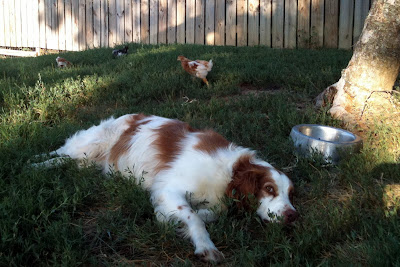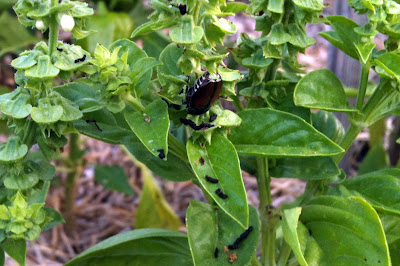Might as well get the bad news out of the way first. After two years without harming a bird, the dogs killed two of my young hens. They haven't bothered the full grown hens, but the little ones darting about apparently stimulated their inner carnivore. I looked out the window and saw them bouncing around having a great time with one of the hens in Crash's (our male) mouth. They were harshly reprimanded, shown the dead bird, and then reprimanded again whenever they showed interest in it. I've kept them chained up when I'm not in the backyard. It's going to be hard to trust them around the birds again.
Insect Report:
|
|
Flea beetles on an eggplant
|
Flea beetles attack my eggplants every year, making the small holes in the leaves that you can see in the picture above. Unless the population really gets out of control, they don't really seem to hurt the plants much. They are interesting beetles in that, when disturbed, they can hop very quickly like the fleas they are named after. A dose of neem oil mixed with pyrethrin (aka
NeemII) gets rid of them. These are both organic treatments.
 |
| Japanese beetles eating an okra leaf |
 |
| Japanese beetles minutes after an application of NeemII |
The Japanese beetles are out and trying to eat my green bean vines, apple trees, blueberry bushes, okra, basil, etc. Above, you can graphically see the effects of the aforementioned neem oil/pyrethrin mix. The beetles are only out for 3 weeks or so a year, so two or three applications spread over that time will keep them off of my crops.
|
|
Japanese beetle on sweet basil
|
Pyrethrin kills a broad spectrum of insects, including beneficial insects. The way to protect beneficial insects is to target the beetles by applying it in the late evening after most beneficial insects have quit flying. Pyrethrin is biodegradable and breaks down quickly when exposed to oxygen. Neem oil on the other hand lasts for up to a week, but only kills insects that eat plant leaves.
|
|
Butterfly on flowering sweet basil
|
These basil plants were treated with NeemII less than 24 hours before this picture and video were taken. They are covered in butterflies and literally hundreds of hoverflies. The video doeesn't fully capture the swarm of activity, but it's the best I could do. It's important to use a pest management system that doesn't harm these beneficial insects. Both butterflies and hoverflies are excellent pollinators (meaning more fruit for you) and the larva of many hoverflies eat harmful insects like aphids. If I had just dusted these in Sevin dust, I would have destroyed both.
 |
| Caterpillar hiding in damaged onion leaf |
 |
| Closeup of caterpillar in the onion leaf |
Looking at my onions, I noticed the ends of a few leaves were missing. Upon closer inspection, I caught this guy red-handed inside one of the leaves. I believe it's a
leek moth larvae. I could treat the onions with
Bacillis thuringiensis (BT), but after inspecting them closely I only found a few and the onions are nearing the end of their growing season anyway. I'll just keep an eye on it for now and smash any that I find. Interestingly, they have not affected my two-year-old evergreen bunching onions.
 |
| Okra |
The okra is still in the vegetative growing phase and has not put on fruit yet. This variety (Perkins Long Pod) will get up to 5-6 feet tall with trunks as big around as my wrist before they are done. You can see a definite size difference between the plants on the south (left) end of the bed and those on the north (right). The plants on the north end get less sunlight because they are shaded somewhat by the plants to the south.
 |
| Cherry tomatoes |
 |
| Roma tomatoes |
The Roma tomato plants may not get tall (~2 feet), but they are loaded with fruit. None of which are ripe yet. The cherry tomato plant (Super Sweet 100) has just begun to give a few ripe fruit. Like the Romas, it is loaded with green fruit and blossoms. No evidence of
blossom-end rot this year. The crushed egg shells (calcium) and straw mulch (conserving soil moisture) seem to be working.
 |
| Jalapenos |
The peppers are also loaded with fruit. The straw mulch has really improved the health of my plants.
 |
| Flowering eggplant |
No fruit on the eggplants yet, but they are putting on plenty of purple flowers.
 |
| Onions with an eggplant in the background |
The onions are ready to harvest. This is indicated when the foliage begins to fall down as seen above. Click
HERE for a previous post on harvesting and drying onions.
 |
| Young butternut squash |
 |
| Butternut squash vine on a trellis |
I have had such
problems with squash vine borer (SVB) in the past, that the only squash I'm growing this year is the butternut squash. Butternut squash is said to be resistant to the SVB. So far so good. The vines are 3-5 feet long and are growing up my cattle panel trellises.
 |
| Swiss chard |
The chard is doing what chard does. It's growing with little care or maintenance. Such a great crop.
 |
| Purple-podded pole beans on a trellis |
The pole beans are 3-4 feet long and have yet to flower. The only problem I've had with this variety in the past is with Japanese beetles defoliating them. I have the NeemII ready...
 |
| Turnip |
The warm season growing of turnips has been a huge success. No maintenance and they are ready to harvest.
 |
| New growth on the apple tree |
The apple tree is putting on some new growth after being hit hard by cedar-apple rust. I've treated it with
Serenade and this is a promising sign. I plan preventive treatments next spring starting in April.
 |
| Blueberry bush |
The two blueberry bushes are growing gangbusters. I mulched them with straw and that seems t have really helped keep the pots from drying out between waterings.
 |
| Dead strawberry plants |
Speaking of drying out between waterings, the lack of rain combined with 100 degree temperatures and my neglect have killed about two-thirds of my strawberry plants. The cinderblocks being porous and having one side exposed to air, dry out easily. They are easily harvested because of the accesibility, but be aware of the drawback to planting inside the cinderblocks. Being the low maintence gardener that I am, I am ok with this. The strawberry plants that remain can obviously handle drought better than those that died off, so as the years go on, the genetics of my plants will exhibit drought tolerance.
 |
| Jerusalem artichokes (sunchokes) |
Amongst those weeds is a stand of sunchokes about 4 feet tall. They will put on a beautiful display of small yellow flowers in a month and after it freezes, I will harvest the potato-like tubers.
Chicken and Egg Report:
|
|
Juvenile laying hen next to a juvenile meat bird
|
Again, the size differential between these birds who were born the same day and fed the same feed is astounding.
The white cornish/rock meat birds have become so heavy that they cannot haul themselves back up the ramp to get to the food and water. I put a 2"x4" wire mesh across the end to keep them up top, while allowing the hens access to the nest boxes. The hen's production has leveled off to about 4 eggs per day.
|
|
Out in the proverbial cold
|
When I put the wire in a week ago, more than half of the egg laying chicks were able to squeeze through the wire and come and go as they pleased. Just a week later, they have grown such that only two of them can still fit through. The ones that can't fit through, spend their days foraging in the yard for insects, worms, and vegetation. We've mysteriously lost two more of them (down to 7). I can't blame the dogs. Since I found no feathers or other remains, my money is on hawks. I'm going to let the dogs run free again as a deterrent to the hawks. We'll see how that goes.
-We finally got a break from the heat and got a little rain to boot! Temperatures will remain in the mid to upper 90s this week with little further chance of rain. Keep your gardens watered.
-Cherry tomatoes
-Turnips
-Herbs
-Serrano, jalapeno, and bell peppers
-Green, yellow, and purple onions
.

































